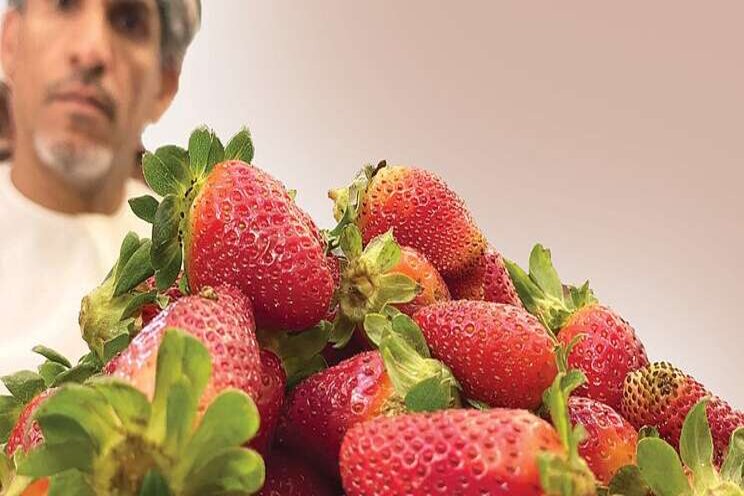Now 'Made in Oman' strawberries!
Added on 22 February 2021

Fahad al Hajri, exemplifying an emerging cadre of agripreneurs, sparked incredulity on social media last week when he posted pictures of his latest harvest: strawberries - piles of it, in all their luscious, bright red glory.
Adding to their disbelief was the revelation that the fruit was farmed not in the likes of Al Jabal al Akdhar, famed for its terraced fruit orchards, or in the fertile farms of the Batinah coast, but in windswept Bidiya in North Al Sharqiyah Governorate.
A private sector employee, Fahad has long been passionate about fruit and vegetable cultivation. His roughly three-acre farm in Bidiya features rows of greenhouses in which he farms a variety of fresh produce, including Omani beans, cucumber, capsicum, eggplant and cabbage.

Last year, the avid planter decided to try his hand at strawberry cultivation for the first time. Procuring grafted saplings from Pakistan, he began planting the sprigs in October, at the start of the winter season. Over the course of several weeks, he planted as many as 900 saplings in neat rows across the farm. Nourished by fertilizer and a simple irrigation system, they yielded a profusion of full-bodied fruit, initially green in colour, but which eventually gave way to a bright red shade.
Late last month, the first strawberry crop from the farm was ready to be harvested. With each plant yielding as much as 500 grams of delicious fruit, Fahad realised he had to secure a market for his home-grown produce. Procuring rigid plastic packs, he began to sell his produce in local stores under the 'Bidiya Strawberry' brand. The response from local consumers was heartening.
At RO 1 per pack of 300 grams, the local brand performed well against imported strawberries shipped in from other parts of the Middle East.
Fahad explained: "Consumers see value-for-money in my product. Not only is the price competitive, but they are assured farm fresh strawberries grown locally in hygiene settings and without harmful pesticides. Imported produce, on the hand, typically spend several days in transit or in storage, and is not as fresh in comparison."
Eager to optimise value generation from the strawberry crop, Fahad also prepared a selection of home-made jams from the fruit. Taking samples to the local hypermarket, he was elated when staffers in charge of the preserves section gave him a big thumbs-up.
To be sure, Fahad is not the first Omani grower to venture into strawberry farming. Others have tried their hand at strawberry cultivation, with varying degrees of success. But Fahad's success in not only growing this much-coveted fruit, and to market it as well, is sure to inspire others to follow in his footsteps.
Buoyed by his maiden success, Fahad plans to expand his strawberry business at the start of the next season in October. Visitors to his farm will also have the opportunity to go about strawberry-tasting, he adds.
Of late, Omanis have taken to social media to flaunt some of their exploits in fruit and vegetable farming. Over the past week ago, a farmer in Dhank in Dhahirah Governorate posted images of freshly harvested carrots grown in a variety of colours. Just earlier, another farmer showed off home-grown tomatoes, not in their customary bright red shade, but bituminous black.
Source and Photo Courtesy of Oman Daily Observer
Source: Oman Daily Observer
More news















